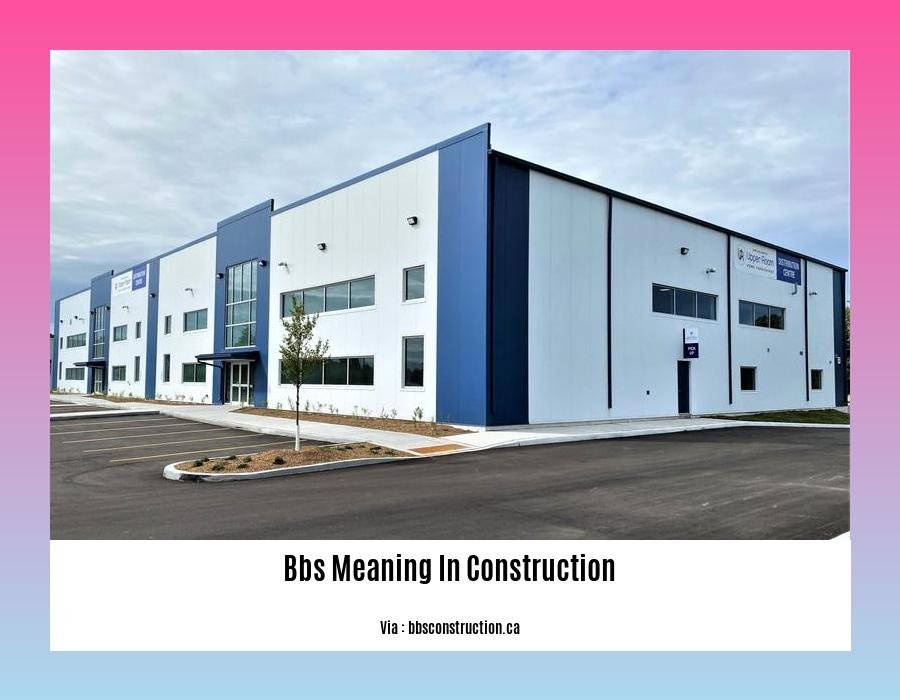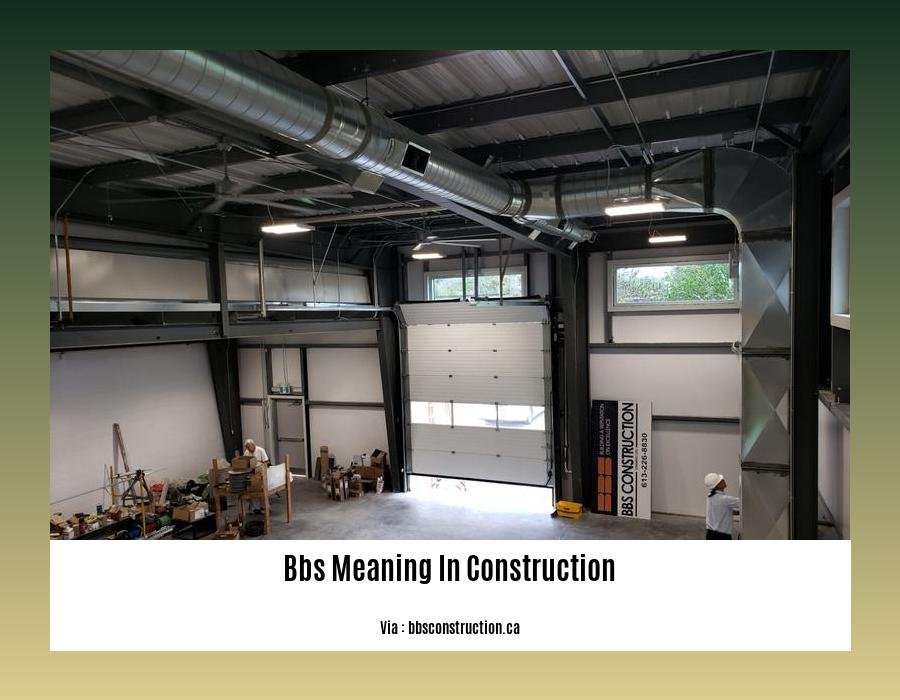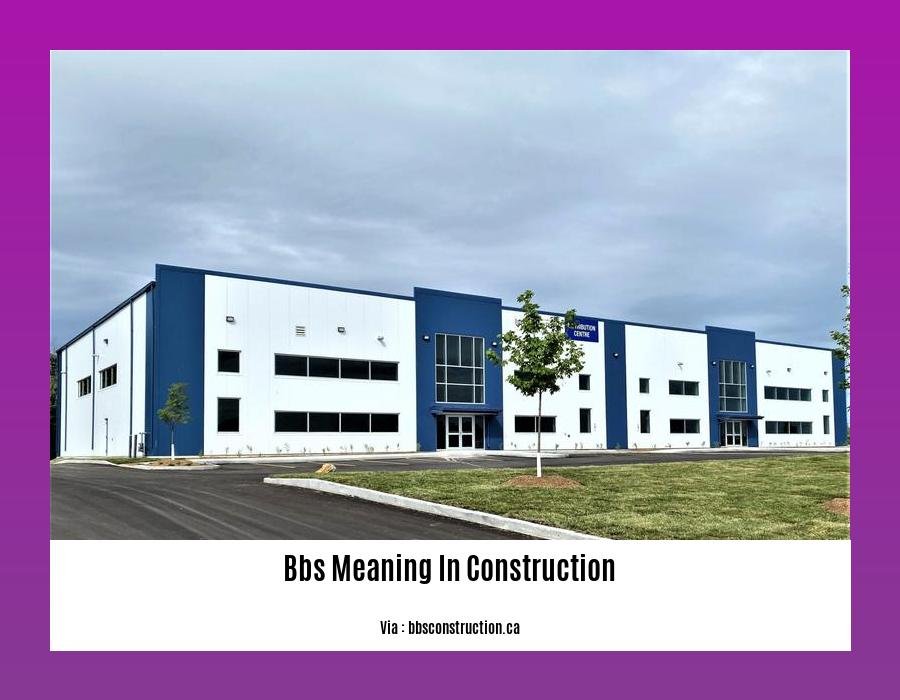Embark on a journey into the realm of construction terminology as we delve into the [BBS Meaning in Construction: Understanding Building Block System]. This comprehensive guide unravels the intricacies of this innovative building approach, shedding light on its applications, advantages, and transformative impact on the construction industry.
Key Takeaways:
- A BBS is a comprehensive list of technical specifications for reinforcement bars in a structure.
- It provides detailed information on bar location, type, size, length, and bending requirements.
- BBS assists in estimating steel quantity, calculating cutting and bending lengths, determining bending angles, and counting the number of bars needed.
- It helps identify bar shapes and calculate total material costs.
- BBS facilitates efficient and accurate construction planning and execution.
BBS Meaning in Construction

The Bar Bending Schedule (BBS) is a crucial document in construction, providing a detailed blueprint for the reinforcement bars used in a structure. It serves as a roadmap for fabricators to cut, bend, and shape these bars precisely, ensuring the structural integrity of the building.
Function of BBS in Construction
The BBS plays several key roles:
- Quantity Estimation: It specifies the number, length, and weight of reinforcement bars required.
- Cutting and Bending Details: It dictates the exact cutting and bending dimensions of each bar.
- Bar Identification: It provides unique identifiers for each bar, aiding in quality control and traceability.
- Cost Calculation: The BBS helps estimate the project material costs.
Benefits of Using BBS
- Accurate Reinforcement: Proper execution of BBS guidelines ensures that the reinforcement matches design specifications, enhancing structural stability.
- Optimized Material Usage: BBS minimizes material waste by optimizing bar lengths and bending angles.
- Time-Saving: BBS eliminates guesswork, allowing quick and accurate fabrication of reinforcement bars.
- Enhanced Safety: Correctly bent and placed bars reduce the risk of accidents during construction.
Challenges of BBS Implementation
- Complexity: BBS creation can be complex for large and intricate structures, requiring specialized knowledge and software.
- Accuracy: Minor errors in BBS can have significant consequences, requiring strict adherence to design specifications.
- Communication: Clear communication between designers, fabricators, and contractors is crucial for effective BBS implementation.
By understanding the BBS meaning in construction, we appreciate its significance in ensuring the structural integrity, efficiency, and safety of buildings.
-
Explore the intricacies of balcony construction with our comprehensive guide on balcony construction details.
-
Discover the cost-effective secrets of building a 5 marla house in Pakistan in our in-depth analysis: 5 marla house construction cost in Pakistan 2023.
-
Enhance your construction knowledge with our exploration of the basic concept in construction productivity enhancement.
-
Find a reliable partner for your construction needs with our directory of basic construction company.
-
Decipher the industry jargon with our explanation of BBM full form in construction.
-
Gain a thorough understanding of the structural element with our article on beam in construction meaning.
Advantages of using BBS in construction

Behavior-based safety (BBS) is a proactive approach to safety in the construction industry that focuses on changing employee behavior to improve safety outcomes. BBS programs typically involve observing employee behavior, providing feedback, and rewarding positive behaviors that align with safety goals.
There are many advantages to using BBS in construction, including:
- Reduced accident rates: BBS programs have been shown to reduce accident rates by up to 50% by identifying and modifying at-risk behaviors.
- Improved safety culture: BBS programs help to create a positive safety culture in the workplace where employees are more likely to take responsibility for their own safety and the safety of others.
- Increased productivity: By reducing accidents and injuries, BBS programs can help to increase productivity by minimizing downtime and lost workdays due to injuries.
- Improved employee morale: BBS programs can help to improve employee morale by showing employees that the company cares about their safety and well-being.
Key Takeaways:
- BBS encourages employee participation in safety and fosters a positive safety culture.
- It promotes efficient use of resources, potentially saving time and money on construction sites.
- BBS provides a structured framework for ongoing safety improvement efforts.
- Positive reinforcement is used to reinforce desirable behaviors and encourage a constructive approach to safety.
- BBS enhances communication and relationships among workers, leading to better coordination and teamwork.
Relevant Sources:
- The Pros and Cons of Behavior-Based Safety (BBS) in Construction
- The Benefits of Behavioral Based Safety (BBS) in Construction
Limitations of using BBS in construction
BBS, while effective, has some Limitations that should be considered:
-
May Not Be Applicable for All Companies: BBS may not be suitable for every construction company, particularly those with a small workforce or limited safety resources. It requires significant effort and resources to implement and maintain effectively.
-
Cultural Differences: BBS may not be easily generalizable across different cultures. Cultural factors can influence how employees perceive and respond to safety programs, and BBS may need to be adapted to fit the specific cultural context of each workplace.
Key Takeaways:
- BBS may not be appropriate for all construction companies, especially those with limited resources or workforce size.
- Cultural differences should be considered when implementing BBS to ensure its effectiveness.
Relevant Sources:
- The Pros and Cons of Behavior-Based Safety (BBS) in Construction
- The Limitations of Behavior-Based Safety (BBS)
Trends and advancements in BBS usage
Behavior-based safety (BBS) has gained tremendous traction in the construction industry as companies seek to enhance safety and risk management. BBS focuses on observing and addressing workers’ daily behaviors and identifying areas for improvement. This proactive approach aims to reduce accidents and injuries by fostering a positive safety culture.
Benefits of BBS:
- Encourages active employee participation in safety measures, fostering a sense of ownership.
- Promotes efficient resource utilization, potentially saving time and money on construction sites.
- Provides a structured framework for ongoing safety improvement initiatives.
- Reinforces desirable behaviors through positive reinforcement, cultivating a constructive safety approach.
- Strengthens communication and working relationships among workers, leading to better coordination and teamwork.
Key Takeaways:
- BBS emphasizes the importance of observing and addressing daily behaviors to improve safety.
- It promotes a collaborative safety culture where employees actively participate in risk management.
- BBS can lead to significant cost savings by reducing accidents and injuries on construction sites.
- Positive reinforcement is a key component of BBS, encouraging workers to adopt safe behaviors.
- Effective communication and teamwork are essential for successful BBS implementation.
Relevant Sources:
- The Pros and Cons of Behavior-Based Safety (BBS) in Construction
- The Benefits of Behavioral Based Safety (BBS) in Construction
FAQ
Q1: What is a Bar Bending Schedule (BBS) in construction?
Q2: What are the benefits of using a BBS in construction?
Q3: How does a BBS help with estimating quantities and costs of reinforcement bars?
Q4: What is Behavioral Based Safety (BBS) in construction?
Q5: How does BBS promote a positive safety culture and improve communication among workers?
- The Best Battery Picture Lamps for Effortless Artwork Illumination - April 1, 2025
- Double Sink Bath Vanity Tops: A Buyer’s Guide - April 1, 2025
- Bath Towel Measurements: A Complete Guide to Choosing the Right Size - April 1, 2025










